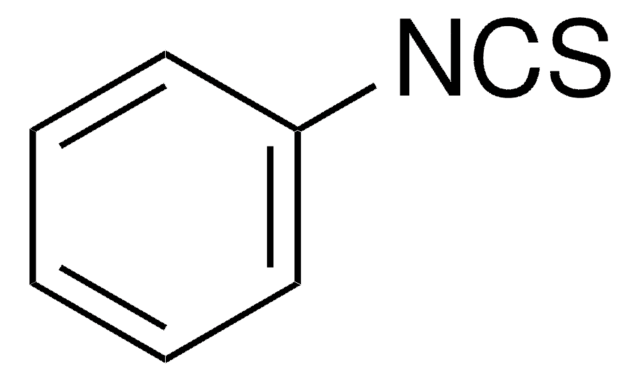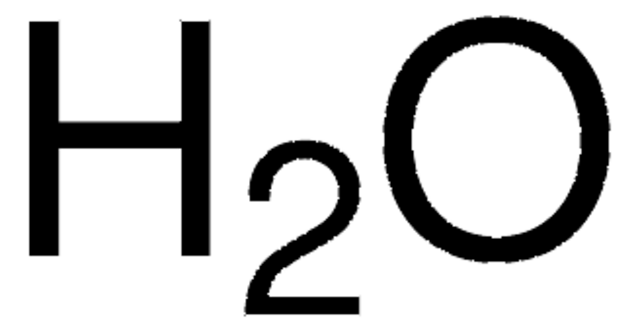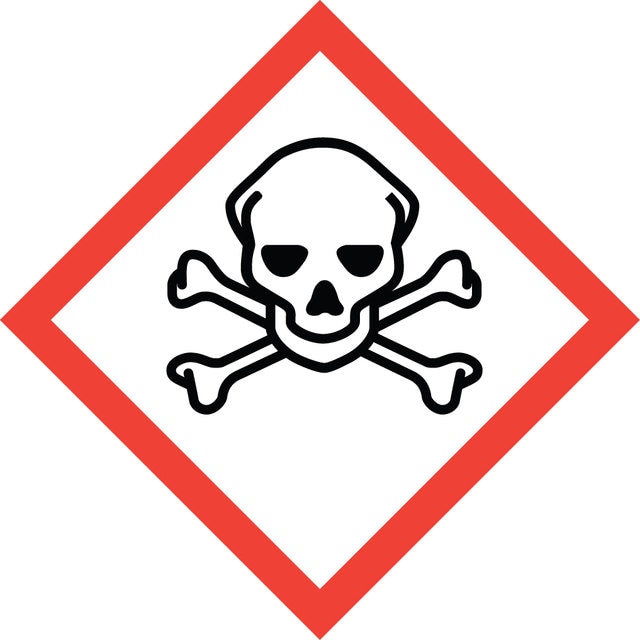P1034
Phenyl isothiocyanate
Sigma Grade, 8.36 M, suitable for solid phase protein sequencing analysis, ≥99% (GC), liquid
동의어(들):
PITC
로그인조직 및 계약 가격 보기
모든 사진(1)
About This Item
Linear Formula:
C6H5NCS
CAS Number:
Molecular Weight:
135.19
Beilstein:
471392
EC Number:
MDL number:
UNSPSC 코드:
12352118
PubChem Substance ID:
NACRES:
NA.31
추천 제품
Grade
Sigma Grade
Quality Level
분석
≥99% (GC)
양식
liquid
농도
8.36 M
refractive index
n20/D 1.6515 (lit.)
bp
218 °C (lit.)
mp
−21 °C (lit.)
density
1.132 g/mL at 20 °C (lit.)
적합성
suitable for solid phase protein sequencing analysis
저장 온도
2-8°C
SMILES string
S=C=Nc1ccccc1
InChI
1S/C7H5NS/c9-6-8-7-4-2-1-3-5-7/h1-5H
InChI key
QKFJKGMPGYROCL-UHFFFAOYSA-N
유사한 제품을 찾으십니까? 방문 제품 비교 안내
일반 설명
Phenyl isothiocyanate belongs to the class of aromatic compounds with isothiocyanate groups. It is typically used as a precolumn derivatization agent for the formation of phenylthiocarbamyl amino acids for their subsequent determination using chromatography techniques.
애플리케이션
Derivatizing reagent for primary and secondary amines. Used in sequencing peptides by Edman degradation and in amino acid analyses by HPLC.
Phenyl isothiocyanate may be used in the polypeptide and protein sequencing at the subpicomole and subnanomole levels, respectively, by applying automated Edman chemistry followed by the analysis using high-performance liquid chromatography (HPLC) technique.
포장
One mL size packaged in flame sealed amber ampules under argon.
Ten mL size packaged in screw cap amber vials under argon.
Ten mL size packaged in screw cap amber vials under argon.
신호어
Danger
유해 및 위험 성명서
Hazard Classifications
Acute Tox. 3 Oral - Resp. Sens. 1 - Skin Corr. 1B - Skin Sens. 1
Storage Class Code
6.1A - Combustible acute toxic Cat. 1 and 2 / very toxic hazardous materials
WGK
WGK 3
Flash Point (°F)
190.4 °F - closed cup
Flash Point (°C)
88 °C - closed cup
개인 보호 장비
Faceshields, Gloves, Goggles, type ABEK (EN14387) respirator filter
이미 열람한 고객
R F Ebert
Analytical biochemistry, 154(2), 431-435 (1986-05-01)
A method for analysis of phenylthiocarbamyl-amino acids by HPLC is described. Solvent A contains 0.05 M sodium acetate plus triethylamine (2.75 ml/liter) adjusted to pH 6.40 with phosphoric acid. Solvent B consists of 50% solvent A, 40% acetonitrile, and 10%
R L Heinrikson et al.
Analytical biochemistry, 136(1), 65-74 (1984-01-01)
Methods for the quantitative derivatization of amino acids with phenylisothiocyanate and for the separation and quantitation of the resulting phenylthiocarbamyl derivatives by reverse-phase high-performance liquid chromatography are described. Phenylthiocarbamylation of amino acids proceeds smoothly in 5 to 10 min at
Examination of automated polypeptide sequencing using standard phenyl isothiocyanate reagent and subpicomole high-performance liquid chromatographic analysis
Tempst P and Riviere L
Analytical Biochemistry, 183(2), 290-300 (1989)
Misako Aito-Inoue et al.
Journal of agricultural and food chemistry, 54(15), 5261-5266 (2006-07-20)
For the isolation and detection of food-derived peptides in blood, an approach based on the derivatization of peptides with phenyl isothiocyanate (PITC) was developed. This approach allows hydrophilic peptides to be resolved and specifically detected by reversed-phase (RP) HPLC. For
R Gheshlaghi et al.
Analytical biochemistry, 383(1), 93-102 (2008-08-30)
Modified resolution and overall separation factors used to quantify the separation of complex chromatography systems are described. These factors were proven to be applicable to the optimization of amino acid resolution in reverse-phase (RP) HPLC chromatograms. To optimize precolumn derivatization
자사의 과학자팀은 생명 과학, 재료 과학, 화학 합성, 크로마토그래피, 분석 및 기타 많은 영역을 포함한 모든 과학 분야에 경험이 있습니다..
고객지원팀으로 연락바랍니다.












